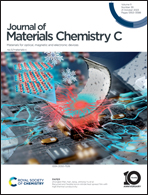Far-red emission carbon dot–metal organic frameworks composite for plant growth regulation application†
Abstract
Light-emitting diodes (LEDs) are commonly used in plant lighting and displays because they emit red, green, blue, and other colors of monochromatic light with a relatively limited spectrum. In this paper, mesoporous zirconium-based metal–organic frameworks (m-UiO-66) were synthesized via a template-free method, and red carbon dots (pCDs) were synthesized via a solvothermal method. The red carbon dots were finally inserted into the mesoporous metal–organic framework's pores while being heated and stirred, which led to the production of pCDs@m-UiO-66. The findings demonstrate that pCDs@m-UiO-66 has high stability at room temperature in addition to being able to produce solid-state luminescence following the co-assembly of red carbon dots with mesoporous metal–organic frameworks. Moreover, the position of its emission peak was red-shifted and its emission properties could meet the light requirements of plant growth. The cultivation trials showed that this far-red emitting phosphor can be used to prepare FR-LED plant lighting lamps when mixed with YAG:Ce3+, which is useful to increase the biomass of Italian lettuce and drench beet seedlings due to their optimized luminescent properties.



 Please wait while we load your content...
Please wait while we load your content...